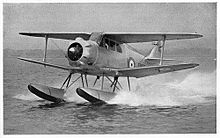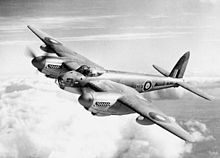Air Ministry Specification
The Air Ministry Specifications were a designation system used from 1917 to 1949 to uniquely identify the technical tendering requirements for aircraft of the British Air Ministry . Operational Requirements (OR) were the preliminary stage to an Air Ministry Specification and were numbered starting with "1". One example is the OR.229, which led to the AM Specification B.35 / 46, from which the Avro Vulcan and Handley Page Victor emerged .
history





In Great Britain before the First World War the Royal Flying Corps (RFC) was officially responsible as a superordinate organization for both “military” and “naval aviation”. However, constant disputes over competence between the army and the navy ultimately led to the Admiralty controlling the naval air force alone and setting up the Royal Naval Air Service (RNAS) in July 1914 . As a result of the resulting competing tenders with often identical requirements, a decree was issued in February 1916 according to which the two military services had to provide a facility to coordinate the corresponding tenders. A cabinet minister was appointed chairman to oversee the established Air Board. The Air Board should issue recommendations to the war committee that equally cover the operational needs of both services and should ensure effective and cost-effective processing.
1917 system
The powers of the Air Board were expanded in April 1917 to the effect that it was now also allowed to determine which type of aircraft would best fulfill a certain, defined role in the two services. A separate numerical system was introduced to identify each decision. RFC alerts were prefixed with "A" and "N" was reserved for those from the RNAS. Single-seaters were marked with the number “1” (A.1 for the RFC and N.1 for the RNAS) and two-seaters with a “2”. In addition, a further subdivision could be made with a suffix in brackets. The system began with the Type A.1 (a) (see also the designation system for aircraft of the British Armed Forces ), a single-engine, single-seat fighter that was supposed to offer pilots the best possible visibility. The British Aerial Transport Company (BAT), Sopwith and Westland responded to this first official tender with design proposals. So with the Sopwith Snipe as the winner, the first aircraft according to official tender specifications was created.
1920 system
In January 1920 a completely new numerical system was introduced which was structured in such a way that it began with the “1” followed by a “/” and the last two digits of the year of issue. With the “1/20” tender, a system was introduced that in principle remained valid for the next 29 years. Only in 1927 was a prefix introduced in front of the first digit, which indicated the intended use of the aircraft. This system was applied consistently and it went so far that specification numbers were even assigned to individual variants of a basic model. An example is the Hawker Fury , the prototype of which was built according to the number F.20 / 27. For the production version Mk. I it was the numbers F.13 / 30, F.13 / 32, F.14 / 32 and for the Mk. II the F.6 / 35. In 1938 the rule was introduced that only prototypes and conceptual drafts of the same aircraft receive specification numbers. If a manufacturer developed an aircraft without an official order at its own risk, a corresponding number could also be assigned retrospectively. An example of this is the de Havilland DH.98 Mosquito .
The prefix identifiers introduced from 1927 were initially "B" for multi-engine bombers, "C" for transporters (cargo), "F" for land-based fighters, "M" for torpedo bombers, "N" for naval fighters , "R" for reconnaissance. But new identifiers were soon added: "A": Army Co-Operation, "E": Experimental, "G": General Purpose, "O": Observer (observation), "P": lighter Bomber, "Q": radio-controlled unmanned target actors, "X": glider.
While about 20 tenders were carried out per year up to 1933, the number rose with the rearmament efforts of Nazi Germany to 40 in 1934, then to over 41 in 1935 and to 47 in 1936. After the aforementioned restriction to prototypes and conceptual drafts, it fell this number then steadily (in 1941 to 12, in 1942 it was still 11), not least because of an incipient saturation effect for the new samples that were written out and necessary.
| AMSpec. | use | template | AMSpec. | use | template |
|---|---|---|---|---|---|
| 1/20 | Transport of spare parts | Bristol Tramp | F.7 / 30 | single-seat day fighter | Gloster Gladiator |
| 2/20 | single seat bomber | Avro Aldershot , De Havilland DH.27 Derby | F.15 / 30 | two-seat day fighter | Hawker Demon |
| 3/20 | single-seat torpedo carrier | Blackburn Dart , Handley Page Hanley | 18/30 | Day bomber | Fairey Gordon |
| 4/20 | Photo reconnaissance | Boulton Paul Bolton | 25/31 | light day bomber | Hawker Hind |
| 5/20 | Troop transport | Armstrong Whitworth Awana , Vickers Victoria | 4/33 | Torpedo bombers | Blackburn Baffin |
| 7/20 | Marine, observer | Supermarine Seagull | P.15/33 | Marine torpedo bombers | Fairey Swordfish |
| 8/20 | Marine, observer | Westland Walrus | F.36 / 34 | single-seat day fighter | Hawker Hurricane |
| 9/20 | Mail transport | Boulton Paul Bodmin , Parnall Possum | F.37 / 34 | single-seat day fighter | Supermarine Spitfire |
| 10/20 | Long range bombers | de Havilland Doncaster | B.1 / 35 | heavy bomber | Vickers Warwick |
| 1/21 | Long range bombers | Vickers Virginia | B. 28/35 | light bomber | Bristol Blenheim |
| 25/22 | Night fighter | Hawker Woodcock | T.23 / 36 | Advanced trainer | Airspeed Oxford |
| 24/25 | Torpedo bombers | Vickers Vildebeest | P.9 / 38 | medium bomber | Armstrong-Whitworth Albemarle |
| 12/26 | single seat bomber | Hawker Hart | F.17 / 39 | twin-engine night fighter | Bristol Beaufighter |
1950 system
At the end of 1949 a slightly changed system was introduced in which the year was omitted and some new abbreviations were introduced. In addition to the abbreviations described above, there were now the prefixes FGA (Fighter Ground Attack), SR (Strike Reconnaissance), GR (Ground Attack), MR (Maritime Reconnaissance), IB (Intruder Bomber) and UB (Unmanned Bomber). The respective status of a tender was indicated by a suffix: After the transmission to the companies, there was a T as a suffix, the further development was marked by a D, before finally the tender identifier was followed by a P after a prototype was built. The sequential numbering started at 100.
The first construction according to these specifications was the Short SB.5 , which was developed according to the requirements of ER.100.
| AMSpec. | use | template |
|---|---|---|
| ER.100 | Swept wing research | Short SB.5 |
| ER.103 | High speed delta wing research | Fairey FD.2 |
| B.104 / OR.285 | Boy scouts / bombers | Vickers Valiant B.2 |
| F.105P / P2 / D2 | single seat fighter | Supermarine Swift |
| F.108 | All-weather fighter | de Havilland DH.112 Venom NF.2 |
| N.113 | single-seat naval fighter (derived from N.9 / 47) | Supermarine Scimitar |
| GR.117 | Submarine hunter (series version) | Fairey Gannet AS.2 and AS.4 |
| GR.117 / OR.220 | Navy early warning aircraft | Fairey Gannet AEW.3 |
| T.117 | Navy trainer aircraft | Fairey Gannet T.2 and T.7 |
| IB.122 | Intruder bomber | English Electric Canberra B (I) .8 |
| HR.127 | Series production of helicopters (all variants) | Westland Whirlwind |
| B.128P | Medium range bomber (series) | Handley Page Victor B.1 and B.2 |
| B.129P | Medium range bomber (series) | Avro Vulcan B.1 and B.2 |
| C.132 | Long distance transporter | Vickers V1000 (canceled) |
| ER.134 | High speed research | Bristol 188 |
| F.138P | Interceptor with mixed propulsion | Saunders-Roe SR.53 |
| N.139P | Marine all-weather fighter | De Havilland DH.110 Sea Vixen |
| ER.143 | V / STOL research | Short SC.1 |
| M.148T | two-seat naval fighter aircraft | Blackburn Buccaneer |
| H.150 | Double rotor helicopter (series) | Bristol Belvedere |
However, there were also aircraft for which neither an OR number nor a specification code was assigned during their development and use . One example is the Avro Ashton , which played an important role in the research and development of avionics elements and engines. In individual cases, the prototypes were given a factory designation based on the specification identifier. This was the case with the BAC 221, which was first developed according to ER.193 and then according to ER.221. Another example is the Saunders-Roe SR.177 , which was created according to the requirements of F.177D.
See also
literature
- Barry Jones: The Right Tools for the Job, A History of British Military Aircraft Specifications (Part 1) . In Airplane Monthly, November 2005, pp. 36-41
- Barry Jones: Swords - and Plowshares, A History of British Military Aircraft Specifications (Part 2) . In Airplane Monthly, January 2006, pp. 54-58
- Barry Jones: The Cold War Generation, A History of British Military Aircraft Specifications (Part 3) . In: Airplane Monthly, March 2006, pp. 78-83
- Barry Jones: Contraction & Collaboration, A History of British Military Aircraft Specifications (Part 4) . In: Airplane Monthly, May 2006, pp. 76-80
- Ken Meekcoms & Eric Morgan: The British Aircraft Specifications File , Air Britain Publication, ISBN 0-85130-220-3
